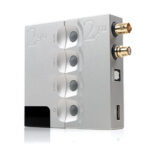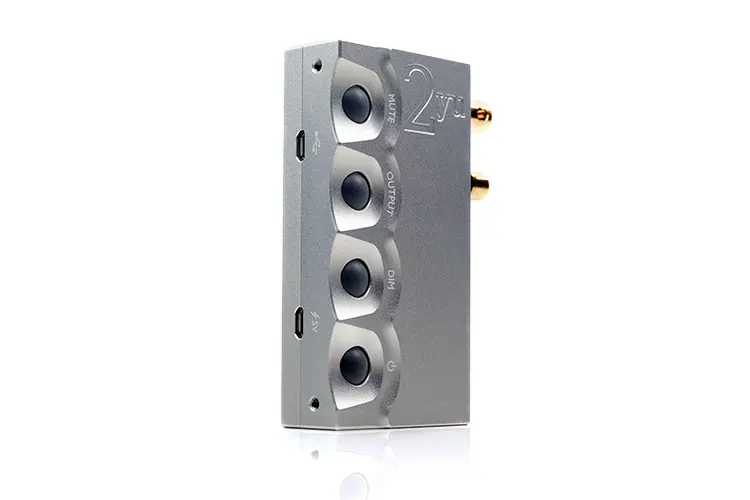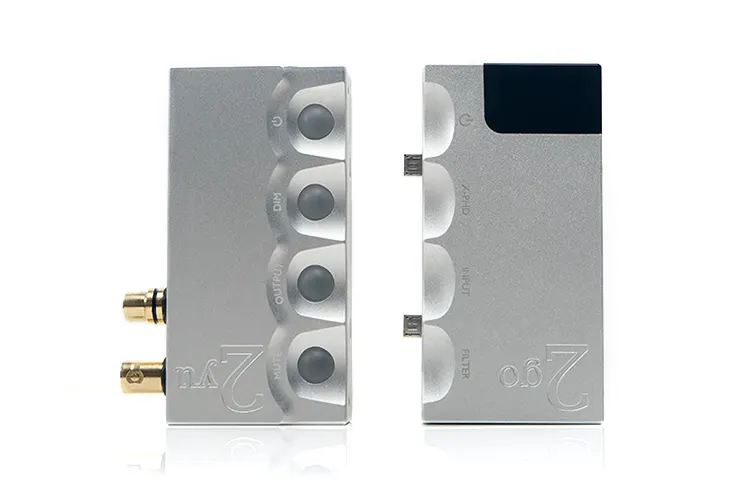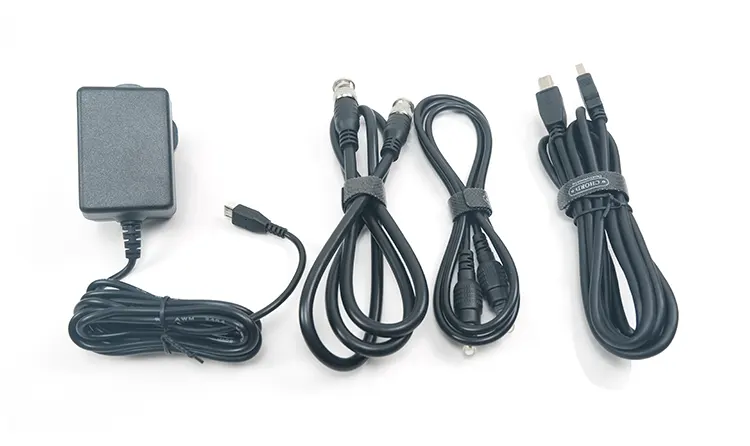We review the Chord Electronics 2yu, which is a digital network bridge that links with the 2go to bring streaming audio to your desktop devices. It is priced at £449 in the UK and $650 in the US.
Disclaimer: This sample was sent to us in exchange for our honest opinion. Headfonics is an independent website with no affiliate links or status. We thank the team at Chord Electronics for their support.
You can read more about the Chord Electronics products we have previously featured on Headfonics by clicking here.
Note that this article follows our current scoring guidelines, which you can read in more detail here.
Technically, the 2yu was released a couple of years ago though the spotlight at the time was very much on its sibling or modular partner, the wireless streaming 2go module.
Understandably really because the 2yu cannot function in its own right without the 2go and if you are considering dabbling with Chord Electronics streaming products, it is likely that is where you will start alongside the Poly.
However, not every Chord Electronics customer owns a Hugo 2, or one of the Mojo variations. Products that neatly fit with the 2go and the Poly. Quite a large percentage use their desktop gear where, arguably, Chord has a longer more illustrious legacy. None of them are directly compatible with the 2go.
Enter the 2yu. A simple digital bridging device that allows you to harness the features and functionality of the 2go within an entirely home or desktop environment. Now, you can stream wirelessly directly into your M Scaler, Hugo TT2, or Qutest to name but a few without having to go via a 3rd party brand.
Purpose
The 2yu goes hand in hand with the 2go but the 2go does not require the 2yu to function. The 2go is a wireless and BT-capable battery-powered device that primarily interfaces with the Hugo 2 to give you one complete portable product with a wireless streaming dimension.
2go allows you to use DLNA or Airplay to interface with a wide variety of streaming software platforms either via a network LAN connection or by going 2.4GHz wireless or Bluetooth 4.2 aptX.
Wireless streaming can be done via your own network setup, via the internet, or through its own hotspot capability with 2 external storage card slots to create its own media server.
We have already reviewed the 2go and it is that module that is responsible for any real tangible sound quality and the ease with which you can use both of them together via the iOS and Android-compatible Gofigure app.
What the 2yu does is allow you to detach the 2go from the Hugo 2 and create a standalone streaming device and digital network bridge with a wide range of outputs that can interface with pretty much any Chord Electronics standalone DAC that has the reciprocal inputs such as USB, coaxial, or optical.
You are not just limited to Chord Electronics products either. You can attach the 2yu/2go to any 3rd party DAC with matching inputs making the combo a potential standalone streaming device of choice among the slew of streaming devices out there in the market.
Tech Highlights
The 2yu has no built-in DAC, but it does contain a 2000MIPS-capable CPU combined with an integrated sample rate converter or SRC for both PCM and DSD processing. It also possesses a low-jitter controller via a phase lock loop and an XMOS-based USB stage.
The exact decoding capability via the 2yu will be a mix of what the 2go can offer combined with the inherent limitations of the output option that you choose to connect to your DAC.
So, on a high level, the 2yu is capable of outputting a decoded audio signal from 44.1kHz up to 768kHZ for PCM and from DSD 64 up to DSD 256 via either wired LAN ethernet RJ45 or a 2.4GHz capable WIFI connection from 2go.
However, only a USB connection will deliver both DSD256 and 32BIT/768kHz capability. Its BNC and RCA coaxial outputs will further drop the ceiling to DSD64 and 32BIT/384kHz maximum. If you decide to go optical it will provide the maximum capability for this modality but at a lower 24BIT/192kHz and DSD64 rate.
Should the sample rate being received be higher than the maximum output capable the 2yu will automatically downsample to the highest rate possible for the outgoing connection.
However, this is only applicable for rates up to 384kHz for PCM, DS 192kHz, and DSD64 if you plan on using the optical, BNC, and coaxial outputs. Beyond that rate, the audio will be muted. For USB there will be no such issue with rates up to DSD256 and PCM 768kHz all possible.
As with all Chord products, there is no MQA unfolding via 2Go and through 2yu but it will pass MQA through to a connected 3rd party MQA decoder unaffected and that may well be your DAC of choice such as a dCS Bartok or Lina for example.
Design
Every design aspect of the 2yu screams Chord Electronics. It has the unmistakable design language Chord product owners have known and loved for the last number of years.
You get the iconic orb button control and status system clearly labeled and deep-set into a finger-friendly array on one end with all your outputs on the other side.
Just below the controls, you have 2 micro-USB ports for both data and power though they are not meant to be used on their own. The female ports connect to the male equivalent on the 2go module to create one continuous signal and power circuit.
The aircraft-grade aluminum chassis is very compact and solid with a form factor that is more or less the same size and shape as the 2go. And it needs to be because both of them are created to lock together creating one harmoniously-designed device.
The 2yu comes in two color options, black and silver with this sample being the silver version. I would not advise mixing the colors up for the 2go and 2yu, it would look pretty nasty when joined unless you are into two-tone combos.
For the density of the chassis, the overall weight of the 2yu is quite reasonable at just 206g without the 2go attached and 362g with it attached. Once attached it’s about two-thirds the length of the Hugo 2 with a very similar height and width. Given the 2Go needs to fit flush with the Hugo 2 as a combined unit the 2yu/2go similarity is unsurprising.
I/O
All the outputs are placed on one side of the 2yu with the other side purely for digital linking to the 2go. For such a small device the options are pretty good though for a bridge with decent spacing to allow relatively thick cable barrels to connect safely.
When combined with the 2go there is enough weight to prevent any potential for tipping from heavy cable attachments with all 4 blister feet on the base keeping a steady grip.
Since there is no internal DAC as such there are no analog outputs, just digital. However, dual BNC lovers might be disappointed to learn that it has only one BNC connection rather than 2.
For the remaining outputs you get a standard coaxial port and beside that a standard optical and USB-A female port.
Controls
The majority of the interaction with the 2yu is more likely to come via the Gofigure app or a 3rd party streaming software platform with the 2go attached, at least in terms of network interaction and setup.
The 2yu itself is a very easy device to learn and use with a control suite that simply does the job it was designed to do. Everything that controls the 2yu directly is via those physical orbs but the depth or complexity of the operation is refreshingly simple and easy to understand.
Each ‘orb’ has a single control function and it’s all environmental in terms of effect. You have a mute capability for the audio signal, an output switcher to round robin through the various output options, an iterative dimmer option for progressively lowering the orb brightness, and lastly an on-off button.
Power comes through a separate DC plug terminated with a micro-UDB socket and rated at 5v 2amp, which is standard for Chord devices such as the Poly, Hugo, and Qutest. The 2yu has no internal battery so requires the charger at all times to operate.
When connected to the 2go you can power it up by connecting the charger to the 2go which will also charge the 2go battery at the same time so ‘killing 2 birds with one stone’ so to speak.
Sadly, there are no sample rate indicators on the 2yu orbs but since you are streaming to a DAC it is more likely you will see any signal sample rate there.
Interfacing with 2go
Connecting the 2yu to the 2go is very simple and should take the length of time to screw in the two locking pins from the 2go accessories to steady the two devices when joined.
Simply, align the micro-USB slots from the 2yu to the 2go, and push them together. Then, locate the two small threaded holes on either side of the 2go and use the 2go Allen keys combined with its 2 locking pins to screw everything in but not overly tight either, enough to keep them securely in place.
My one critique? I would have liked to have seen a fresh set of Allen keys and locking pins supplied with the 2yu. these are small screws so to speak and if you drop them or lose them they are not easy to replace. A spare set would have been ideal, especially if you have a Hugo 2 and will be locking and unlocking the 2go a lot.
Packaging & Accessories
The Chord Electronics 2yu is nicely packaged with a generous supply of accessories.
The outer retail packaging is a jewelry-style case consistent with a lot of Chord’s other product boxes such as the Qutest or the Huei. This is a flip-lid black box with the 2yu tucked into a protective padded top layer and a sliding drawer underneath containing the accessories in a branded velvet pouch.
Inside the pouch, you get the DC charger and a host of cables to allow you to immediately connect the 2yu to the DAC of your choice including BNC, optical, and USB. The only thing missing is a standard coaxial cable and the aforementioned additional locking pins and a spare Allen key. Otherwise, you are able to start using the 2yu right out of the box.
Click on page 2 below for performance impressions and our selected pairings.









